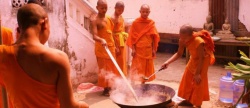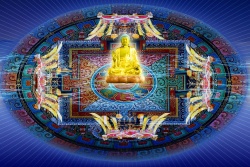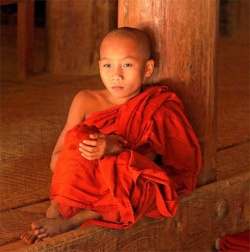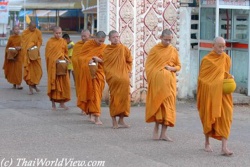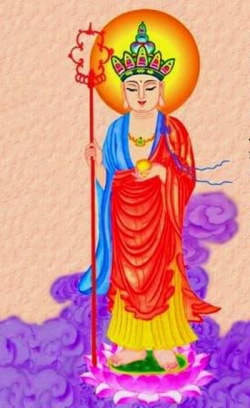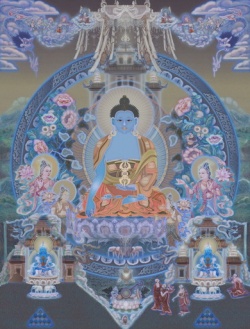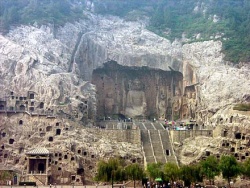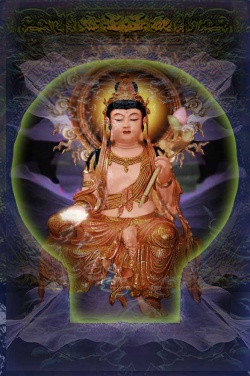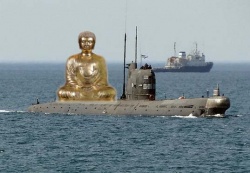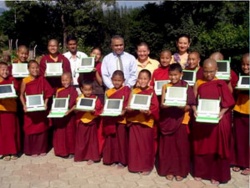East Mountain Teaching Explained
East Mountain Teaching denotes the teachings of the Fourth Ancestor Dayi Daoxin, his student and heir the Fifth Ancestor Daman Hongren, and their students and lineage of Chan Buddhism.
East Mountain Teaching gets its name from the East Mountain Temple on the "Twin Peaks" of Huangmei (modern Hubei).
The East Mountain Temple was on the easternmost peak of the two.
Its modern name is Wuzu Temple .
The two most famous disciples of Hongren, Huineng and Yuquan Shenxiu, both continued the East Mountain teaching.
History
The East Mountain School was established by Daoxin (Chinese: 道信 580–651) at East Mountain Temple on Potou (Broken Head) Mountain, which was later renamed Shuangfeng (Twin Peaks).
Daoxin taught there for 30 years. He established the first monastic home for "Bodhidharma's Zen".
The tradition holds that Hongren (Chinese: 弘忍 601–674) left home at an early age (between seven and fourteen) and lived at East Mountain Temple on Twin Peaks, where Daoxiin was the abbot.
Teachings
The East Mountain community was a specialized meditation training centre.
The establishment of a community in one location was a change from the wandering lives of Bodhiharma and Huike and their followers.
It fitted better into the Chinese society, which highly valued community-oriented behaviour, instead of solitary practice
An important aspect of the East Mountain Teachings was its nonreliance on a single sutra or a single set of sutras for its doctrinal foundation as was done by most of the other Buddhist sects of the time.
The East Mountain School incorporated both the Lankavatara Sutra and the Mahaprajnaparamita Sutras.
The view of the mind in the Awakening of Faith in the Mahayana (Chinese: Ta-ch'eng ch'i-hsin lun) also had a significant import on the doctrinal development of the East Mountain Teaching.
There were three main meditation techniques taught by this school. One was a meditation on emptiness in which one contemplates all dharmas of body and mind as empty.
Another practice was the contemplation of some 'ultimate principle', this was associated with the 'one practice samadhi' (i-hsing sanmei) and in some texts such as the Leng-ch'ieh shih-tzu chi is achieved by meditating on a single Buddha.
The third technique was the practice of concentrating the mind on one thing (kuan i wu) until the mind becomes fixed in samadhi.
The goal of all of these practices was to suppress the stream of thoughts which clouds the mind and allow the practitioner to gain insight into the pure, radiant consciousness in everyone.
Daoxin
Daoxin is credited with several important innovations that led directly to the ability of Zen to become a popular religion. Among his most important contributions were:
The Unification of Zen practice with acceptance of the Buddhist precepts,
The unification of the teachings of the Lankavatara Sutra with those of the Mahaprajnaparamita Sutras, which includes the well-known Heart and Diamond sutras,
The incorporation of chanting, including chanting the name of Buddha, into Zen practice.
Hongren
Hongren was a plain meditation teacher, who taught students of "various religious interests", including "practitioners of the Lotus Sutra, students of Madhyamaka philosophy, or specialists in the monastic regulations of Buddhist Vinaya".
Following Daoxin, Hongren included an emphasis on the Mahaprajnaparamita Sutras, including the Heart Sutra and the Diamond Sutra, along with the emphasis on the Lankavatara Sutra.
Though Hongren was known for not compiling writings and for teaching Zen principles orally, the classical Zen text Discourse on the Highest Vehicle, is attributed to him.
This work emphasizes the practice of "maintaining the original true mind" that "naturally cuts off the arising of delusion."
Split in Northern and Southern School
Originally Shenxiu was considered to be the "Sixth Patriarch", carrying the mantle of Bodhidharma's Zen through the East Mountain School.
After the death of Shenxiu, his student Shenhui started a campaign to establish Huineng as the Sixth Ancestor.
Eventually Shenhui's position won the day, and Huineng was recognized as the Sixth Patriarch.
The successful promulgation of Shenhui's views led to Shenxiu's branch being widely referred to by others as the "Northern School."
This nomenclature has continued in western scholarship, which for the most part has largely viewed Chinese Zen through the lens of southern Chan.
Northern School and Southern School
The terms Northern and Southern have little to do with geography:
The basic difference is between approaches. Shenhui characterised the Northern School as employing gradual teachings, while his Southern school employed sudden teachings:
The term "East Mountain Teaching" is seen as more culturally and historically appropriate.
But the characterization of Shenxiu's East Mountain Teaching as gradualist is argued to be unfounded in light of the documents found amongst Dunhuang manuscripts recovered from the Mogao Caves near Dunhuang.
Shenhui's Southern School incorporated Northern teachings as well, and Shenhui himself admittedly saw the need of further practice after initial awakening.
Shenxiu (神秀, 606?-706 CE)
Yuquan Shenxiu's prominent position in the history of Chán, despite the popular narrative, is recognized by modern scholarship:
Kuiken (undated: p. 17) in discussing a Dunhuang document of the Tang monk and meditator, 'Jingjue' (靜覺, 683- ca. 750) states:
Jingjue's Record introduces Hongren of Huangmei 黃梅宏忍 (d.u.) as the main teacher in the sixth generation of the 'southern' or 'East Mountain meditation tradition.
Shenxiu is mentioned as Hongren's authorized successor.
In Shenxiu's shadow, Jingjue mentions 'old An' 老安 (see A) as a 'seasoned' meditation teacher and some minor 'local disciples' of Hongren.[3]
Shenxiu wrote a treatise on meditation called the Kuan-hsin lun ("treatise on contemplating the mind").
It combines some of the meditation practices taught by Zhiyi with ideas from the Awakening of Faith in the Mahayana
Hui-neng
The story of Huineng is famously worded in the Platform Sutra, a text which originated after Shenhui's death.
Its core may have originated within the so-called Oxhead school.
The text was subsequently edited and enlarged, and reflects various Chán teachings.
It de-emphasizes the difference between the Northern and the Southern School.
The first chapter of the Platform Sutra relates the story of Huineng and his inheritance of the East Mountain Teachings. Wider influence of the East Mountain Teachings
The tradition of a list of patriarchs, which granted credibility to the developing tradition, developed early in the Chán tradition:
Faru (法如, 638-689 CE)
Faru (法如, 638-689) was "the first pioneer" and "actual founde of the Northern School.
His principal teachers were Hui-ming and Daman Hongren (Hung-jen).
He was sent to Hongren by Hui-ming, and attained awakening when studying with Hung-jen
Originally Faru too was credited to be the successor of Hongren.
But Faru did not have a good publicist, and he was not included within the list of Chan Patriarchs.
Because of Faru, the 'Shaolin Monastery', constructed in 496CE, yet again became prominent.
(Faru) had only a brief stay at Shaolin Temple, but during his stay the cloister became the epicentre of the flourishing Chan movement.
An epitaph commemorating the success of Faru's pioneering endeavors is located on Mount Sung.[5]
Baotang Wuzhu
Baotang Wuzhu (, 714-774), founder and abbot of Baotang Monastery in Chengdu in Southwest China was a member of the East Mountain Teachings.
Moheyan (late eighth century CE)
Moheyan (late eighth century CE) was a proponent of the Northern School.
Moheyan traveled to Dunhuang, which at the time belonged to the Tibetan Empire, in 781 or 787 CE.[6]
Moheyan participated in a prolonged debate with Kamalashila at Samye in Tibet over sudden versus gradual teachings, which was decisive for the course the Tibetan Buddhist tradition took:
Broughton identifies the Chinese and Tibetan nomenclature of Mohoyen's teachings and identifies them principally with the East Mountain Teachings:
The teachings of Moheyan and other Chan masters were unified with the Kham Dzogchen lineages
Notes and References
Zeuschner, Robert B. (1978). "The Understanding of Mind in the Northern Line of Ch'an (Zen)."
Philosophy East and West, Volume 28, Number 1 (January 1978). Hawaii, USA: University of Hawaii Press, pp. 69-79
Ray, Gary L.(2005). The Northern Ch'an School and Sudden Versus Gradual Enlightenment Debates in China and Tibet. Source: http://www.dharmaweb.org/index.php/Ch'an_&_Sudden_and_Gradual_Debates_in_China_and_Tibet (accessed: December 2, 2007)
Kuiken, Kees (undated). The Other Neng 2: Part Two Sources and Resources. Source: http://dissertations.ub.rug.nl/FILES/faculties/theology/2002/c.j.kuiken/pt2.pdf (accessed: August 6, 2008) p.17
Gregory, Peter N; Traditions of Meditation in Chinese Buddhism, 106.
